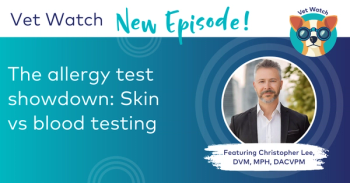
- dvm360 March 2024
- Volume 55
- Issue 3
- Pages: 25
Less is more
Spearheading the path for antimicrobial stewardship
Sponsored by Nextmune
Antimicrobial resistance is growing, which leads to less effective antibiotic treatments. More resistant bacteria create a problem for human and animal health. Adam Christman, DVM, MBA, of dvm360® Live, spoke with Andrew Rosenberg, DVM, DACVD, about the antimicrobial stewardship approach, which utilizes antimicrobial agents in a way that preserves their efficacy, as a potential solution for veterinarians.
Adam Christman, DVM, MBA: What does it mean to use antimicrobial stewardship? How does this understanding lead us to be more prudent?
Andrew Rosenberg, DVM, DACVD: Antimicrobial stewardship is responsibly using antimicrobials to decrease the risk of resistance occurring, and as a result allowing us to maximize our treatment. As resistance is growing we want to ask ourselves, why are these kinds of bacteria becoming more common? Sometimes, bacteria can transfer genetic mutations to other bacteria.
One of the hottest topics we’ve ever seen around antimicrobial resistance is biofilm. Biofilms are when groups of bacteria or yeast conglomerate together on the surface of the skin or even inside the ear, and they embed themselves in a slime layer. When embedded in said slime layer, they are resistant to lots of different antibiotics, physical stresses, and chemical stresses. You want to use products that can disrupt these biofilms and make it easier to kill microorganisms.
Christman: How do you approach the decision-making process for selecting an antimicrobial agent, taking into consideration factors such as culture and sensitivity testing as well as PCR (polymerase chain reaction) testing?
Rosenberg: I would start with topical antimicrobials that don’t have antibiotics, but rather antiseptic ingredients. These do not encourage resistance mechanisms to develop in the first place. Some products contain chlorhexidine. Newer products contain things like microionized silver, which can kill bacteria, yeast, and viruses, and disrupt biofilms.
When choosing an antibiotic, cultures and sensitivity testing can help us. There have been some studies on PCR cultures, some of which are not so favorable. I think it is good technology, but more advancements are needed before we use those on a regular basis.
Christman: Talk to us about some of the topical modalities that are available now.
Rosenberg: BioHex is a line of products that kill microorganisms in a multimodal fashion. It is a combination of chlorhexidine and miconazole—2% and 2% each—that has been shown to be a superior ratio for these two ingredients.It also has microionized silver and ceramides. Ceramides are important moisturizers for the skin that help increase skin barrier function. In most allergic dogs, they have a defective skin barrier, which can allow for more bacteria and yeast to get into that defective skin and create infection. Ceramides help prevent that.
Christman: How do we teach our clients about antimicrobial stewardship from our perspective?
Rosenberg: When educating my clients on what topical products to use, I say this isn’t just to treat infections; it is also to prevent new infections from occurring. I give them a reason why, not just tell them what to do. I will also say if we can use topical products in a good way, and we’re diligent about bathing their pet, we can decrease the need for antibiotics, even the heavy-duty ones.
Christman: How can a One Health approach enhance antimicrobial stewardship in veterinary dermatology
Rosenberg: Antimicrobial resistance is growing everywhere—on the human and veterinary side. If we can limit the use of antibiotics in veterinary medicine using increased topicals, then that benefits everybody.
Christman: Are there specific guidelines or resources for generalists when it comes to antimicrobial stewardship?
Rosenberg: There are 2 great resources out there. The World Association for Veterinary Dermatology has consensus guidelines for the treatment of methicillin-resistant Staphylococcus aureus. It is an open-source article that can be accessed without a subscription. Another resource is the Antimicrobials Working Group. They have robust guidelines on how superficial bacterial folliculitis should be treated in our companion animals.
Articles in this issue
over 1 year ago
A guide to chart-topping activities for Fetch Nashvilleover 1 year ago
The Dilemma: Where do I go from here?over 1 year ago
The most common poisons for petsover 1 year ago
3 secrets to team retentionover 1 year ago
A passion for compassionover 1 year ago
Female sterilization proceduresover 1 year ago
Education is best when it is shared, not hoardedover 1 year ago
Human behavior can help prevent dog bitesover 1 year ago
Empowering veterinary teams and businesses owned by womenNewsletter
From exam room tips to practice management insights, get trusted veterinary news delivered straight to your inbox—subscribe to dvm360.






